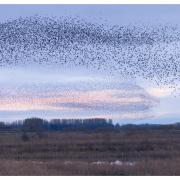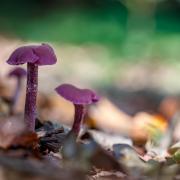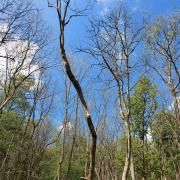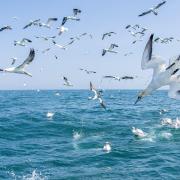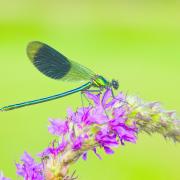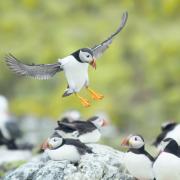Holly Sayer from Yorkshire Wildlife Trust, introduces the wildlife that signals the onset of spring

Just like humans, wildlife reacts to the changes in the year, and the lighter days mean more visible activity. Some will put on quite a show for each other at the start of their mating season: buds open into flowers to attract pollinators, birds call to mates, queen bees appear and hawthorns’ thorny hedgerows are softened with pink blossom.
Skylarks
Between March and July, birds greet the early light with the combined rise and crescendo of the dawn chorus. This increased bird activity is not limited to the early hours – good news for those who don’t rise with the lark. Gardens and parks are full of goldfinches, tits and nuthatches all loudly defending their territories, but the real showstopper is the skylark.
Often heard before it is seen, the skylark (if you ever manage to spot it at all) frequents moorland, farmland or heath. The males perform long and intricate song flights to attract the females; warbling a combination of notes and calls as they rise vertically, and hover up to 300m high before descending. At any time of the day, in blue skies above the open grassland of the Dales or on remote reserves like Brae Pasture, the skylarks’ atmospheric call heralds the arrival of spring.
Orange tip butterflies
Following the peacock and comma butterflies (which can appear in January), orange tips typically show around mid-April, but can be seen as early as March. Due to their widespread distribution, the emergence of the orange tip is thought to signal the return of warmer weather and the arrival of spring in the UK. Males emerge from the chrysalis earlier than females and you may see little flashes of orange dancing in the sunlight of the woodland glade at Yorkshire Wildlife Trust’s Grass Wood, or spy them ‘patrolling’ hedgerows and woodland edges in search of a mate.
During the 43 years of butterfly monitoring in the UK, the range of these butterflies has increased and spread northward, with flight times becoming significantly earlier. This is indicative of how our changing climate disrupts nature’s seasonal signposts and can affect any species – whether for better or worse.
Frogspawn
A sure-sign of the arrival of spring is the steady appearance of frogspawn in ponds across the region. Look out for the clumps or ‘rafts’ of transparent jelly in shaded, shallow and well-vegetated ponds. The most-seen frog species in Yorkshire is the common frog, and though a female frog can lay up to 4,000 eggs over the course of one spring, the majority won’t survive to adulthood.
Frogspawn may appear as early as January and is visible through to April. It takes two to four weeks for the tadpoles to start to appear, which then take 14-16 weeks to fully mature into froglets. If the tadpoles you see are faintly speckled with gold and brown (as opposed to the black frogspawn of the common toad), then they’re common frog tadpoles. Even if you’re alarmed by the mass of spawn, do not interfere; frogs select the ponds in which to breed based on many factors and produce a large amount of frogspawn to increase the chances of survival.
Purple orchids
Nothing says spring quite like colourful wildflowers that start appearing on the hedgerows and verges of winding country lanes. This spring, keep an eye out for the aptly named early-purple orchid, which is the first orchid to bloom in the UK. This wide-ranging orchid is particularly adaptable and can be found in woodland glades, hay-meadows, on coastal cliffs and roadside banks.
Sadly, changes in agricultural technology and increased urbanisation have lessened the abundance of the flowers that Shakespeare named ‘long purples’. However, sympathetic grazing and hay-cutting regimes – like those on Yorkshire Wildlife Trust’s Ashes Pasture – provide these wildflowers with time to bloom, pollinate and set seed during spring and summer. It is well worth visiting these meadows in April and May to catch sight of these purple gems glimmering among the grasses and other wildflowers.
Boxing hares
Typically shy and secretive creatures, in early spring brown hares live up to their ‘mad March’ reputation by becoming increasingly more brazen and energetic as the mating season begins. This season is your best chance of spotting one, or more likely two, as males (bucks) chase females (does) in a hormone-fuelled frenzy across open grassland and meadows. Dawn and dusk are when they are most active, and as those long ears provide them with excellent hearing, be as quiet as you can.
If you’re particularly lucky you might even catch a famous brown hare boxing match. Quite a sight to behold, this is when the doe vents her frustration upon a pursuing buck by turning upon her admirer, standing on her back legs and lashing out with her front paws. The buck mirrors her stance to protect himself and – voila – a brown hare boxing match! u
Holly Sayer is the People and Wildlife Assistant at Yorkshire Wildlife Trust. To find out more about their work, go online to ywt.org.uk.














